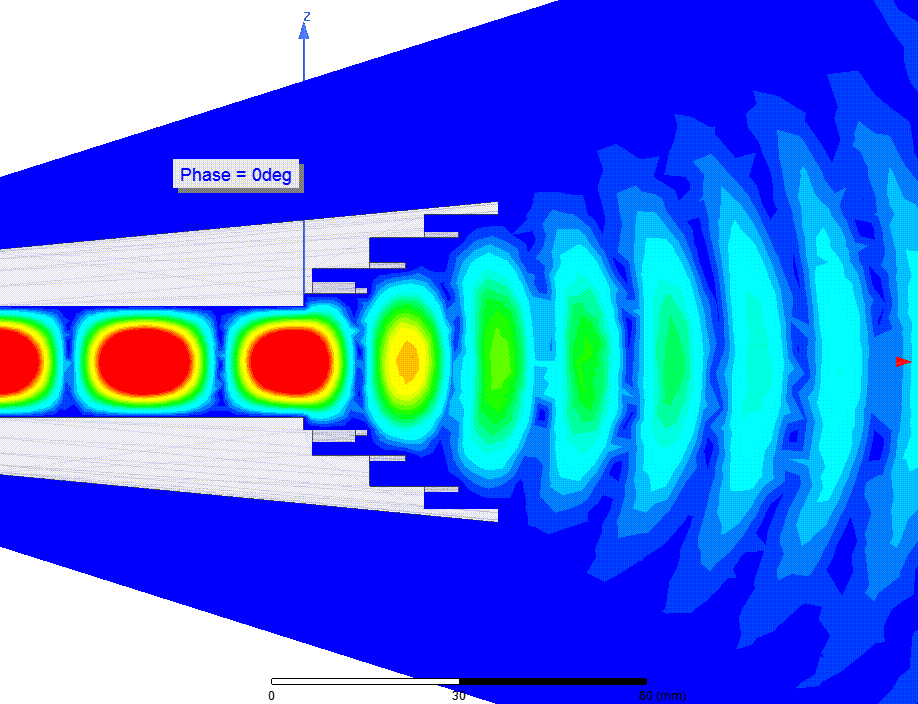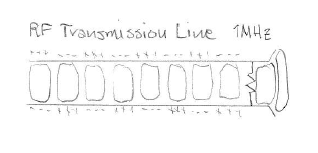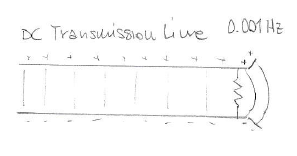Ascribing meaning to the Poynting vector at a point leads us to the wrong conclusion, as shown by Fig. 11.3.1.
I didn't see Haus and Melcher recant what they wrote
"Even with the fields perfectly stationary in time, the power is seen to flow through the open space to be absorbed in the volume where the dissipation takes place."
Did you?
I’m not quite sure what you a trying to say by “glowing red hot”. Are you saying that energy is now transferred through thermal radiation?
No, I'm saying that by making rod and washer of very different materials you can have one glow red hot while the other stays cool, and viceversa. There still will be Poynting field lines in the space inside the can and they will account for the difference between the total power delivered by the battery and the power absorbed by the rod.
In one case you will see a lot of lines coming out of a cool washer to impinge into a red hot rod.
On the next page they say:
" we illustrate the danger of ascribing meaning to S evaluated at a point, rather than integrated over a closed surface."
I'm not sure why you are dragging thermal issues into the argument. We can also make your resistors glow, but why would we? Add a cooling system if you are worried about conductors glowing red.
The point is that there is no power being transferred from the washer to the rod. All the power is accounted for. Misinterpreting the meaning of the Poynting vector leads us to incorrectly believe that power is flowing from the washer to the rod. Please do the calculations. You have all the information you require.
I used the cool washer and hot rod as an as an example of how counterintuitive it would seem to see power flow from a cool object to a hot one. And to highlight that the energy would not come from the cool washer, but from the battery.
Anyway, what follows was written a day or two ago. I had to draw and scan a few pictures and that took time, so some points might already have been discussed.
1) It is undeniable that there are both an electric field and a magnetic field in the space between (and more generally around) the wires. One can measure them.
But most importantly, one can use those fields to do work. Can we say that we are extracting energy from the fields?
I can use the E field to make an electric dipole rotate, for example. Or to slow down dust particles in the space near the wires and make them pile up. I can also use the B field to make a magnetic dipole rotate, like a compass needle in the space near the wires.
It takes energy to make that mechanical energy appear.
2) Where does that energy come from? It is said it comes from the fields.
Granted, the fields in the static case are not linked to one another as the E and B field of an EM wave (more on this in point 5 ), but they are still both generated by charges in your circuit.
static charges: surface charge on the conductors' surfaces and at the interfaces between materials
moving charges: currents flowing in the conductors and displacement currents in dielectrics
the charges moving inside the conductor are the result of the field generated by the static charge on the surface, which in turn is distributed in that way because the battery has been connected to it.
Consider a charge magically materialized in the space between the wires of our circuit. The moment the electric field puts a charge in motion, a magnetic field appears, and the Poynting vector shows the charge 'stealing' energy from the field (changing it).If I put mechanical energy in to force a charge against 'its will' (for example to put it there from the 'chargeOort cloud' at infinity), I will end up adding energy to the field. Again, a Poynting vector field will appear to show energy getting into the field. If I move the charge back and forth slowly (quasistatically), I keep adding and subtracting energy to the field with no radiation.
3) Let's get to the Poynting vector at DC for the resistor alone. Oh, by the way, I hope it is clear that both rod and washers in that Haus & Melcher example are the resistors - the conductor is the cylindrical can.
For a homogeneously cylindrical resistor where a constant DC current is flowing the Poynting vector is directed radially in and decreases in magnitude to zero when it reaches the axis (because that's what the magnetic field magnitude inside does). Is energy disappearing from the universe? Of course not, it just gets converted into something else. The following figure shows the Poynting vector field for a resistor with a 5V potential difference across it:
 fig Poynting for a cylindrical resistor - three cases
fig Poynting for a cylindrical resistor - three casesAll textbooks dealing with energy balance by means of the Poynting field say we must always integrate over a closed surface, so all we can say is that, thanks to the distribution of surface charge on the circuit elements and the ensuing currents flowing, energy is getting into the resistor from outside.
You point out an alternative way to compute the power absorbed by the resistor that does not need to consider the electric and magnetic fields in the space around the conductor and circuital elements. Fine, instead of considering the whole of B you just take j into account. By resorting to the non uniquely defined potential function phi (with that arbitrary additive constant...) this method leads to an infinity of different configurations of energy flows. Same resistor with 5V potential difference, but different choice of the zero potential reference.
 fig alternative Poynting for a cylindrical resistor - three cases
fig alternative Poynting for a cylindrical resistor - three casesLuckily we must only consider the results of integration over a closed surface, still, the phi J representation appears to be weaker than the ExH representation.
Adding to the 'potential' nonuniqueness problem (which, one might argue, affects the ExH representation as well since we can still add an arbitrary zero-divergence vector to ExH), this alternative method is not a general method that takes into consideration the whole physical system. In fact, it does not take into account what happens in the space around the conductors and elements. It ignores the surface charges that give rise to the field inside the conductor, and only considers what happens where the current is flowing. In fact, it's blind in the space between conductors.
4) You say that in Haus and Melcher's example, all energy is accounted for and therefore there is no need to have any transfer between washer and rod. But this is also true in the orange parallel resistors circuit: there is no energy transfer between the first resistor and the second one. In fact the first resistor takes in a net power equal to the power it dissipated in heat via Joule heating. (side note: The first resistor just happens to be in the way of the power transfer from battery to the rest of the circuit. It is not completely useless, though, because its surface charge and the current flowing in it helps in shaping the electric and magnetic fields that will affect the rest of the circuit.)
Moreover what about the perfectly conducting tin can in Haus & Melcher's example? Isn't it connecting the top of the rod with the outer perimeter of the washer? Is there a current flowing there? Is there any power flowing in there? From rod to washer? Let's unfold the geometry, and see what happens when the zero potential reference is placed somewhere else:
 fig nut-washer circuit currents and equivalent circuit
fig nut-washer circuit currents and equivalent circuitSo, is energy flowing through the conductor? Using the phi J representation it looks like the answer depends on where you set the zero for the potential:
 fig nutwasher for three cases
fig nutwasher for three casesWe can see the inconsistencies of this representation of power flow by considering a single resistor with one side directly attached to the battery
 fig one resistor two positions -
fig one resistor two positions -
power flows in the conductor only if the battery is before the resistor?what does these say about the way power go from the battery to the resistor? In one case the conductor is bringing power, in the other is does not? And if we add a conductor on the other side as well, one conductor is bringing power to the resistor and the other one doesn't? Does it reverse if we reverse the polarity?
 fig one resistor two polarities - power flow alternates between the top and bottom conductors?
fig one resistor two polarities - power flow alternates between the top and bottom conductors?And if we call the battery terminals +V/2 and -V/2, power flows into the load from both conductors?
This representation of energy flow is as undetermined as the value of potential.
5) Are all representations doomed to fail? Possibly. After all, every author warns the reader about only considering the results of the integration over closed surfaces. But we know that in the case of antennas, the energy does flow into space. Where does it stop to be in the space between conductors and starts hiding inside conductors (if ever)? When dE/dt becomes significant? What exactly makes the energy hide into the conductors?
Let's start with an EM beam at very high frequency, such as a laser beam. Is the energy in the space occupied by the beam? I guess it is. Let's lower the frequency and consider an RF antenna beam: is the energy in the space? I guess it still is.
 fig antenna beam animation in space
fig antenna beam animation in space
source: sudonullLower it a little more and look at a transmission line feeding an antenna. I will add a resistor to steal some of the energy. Is there energy present in the space occupied by a beam exiting an antenna? If the answer to that question is yes, I would say that there must also be energy in the space between the conductors of the transmission line feeding the antenna.
 fig animation from transmission line to free space
fig animation from transmission line to free spaceNow, keep lowering the frequency. The fields of a single 'cell' are basically following the same configuration, but the 'cells' gets longer and longer.

 fig lowering the frequency
fig lowering the frequencyWe will eventually get to a point where we no longer have appreciable radiation and the pattern gets stationary. Is the energy still in the space between wires as the frequency gets lower and lower?
 fig transmission line from LF to DC - no radiation, just a fringe effect
fig transmission line from LF to DC - no radiation, just a fringe effectWhen does the energy cease to be in the space between the conductors? At 1Hz? At 0.01 Hz? And at 0.00001 Hz? At DC (meaning from bigbang to bigcrunch)?
6) Does the Poynting vector have a meaning when we do not have waves?
When Panofsky and Phillips, a book I respect and revere, consider the energy balance in the quasi-static case, they neglect the contribute of the ExH term because, they say, it goes to zero at least as 1/r^5.
But (and this is my thought) this dependency - which is true in the quasistatic state - is relevant when... r is big. Near the sources, near the wires, with all their surface charge and conduction currents, ExH is usually not negligible. Case in point, in a long cylindrical circuit the magnetic field is approximately constant inside the cylinder, so ExH goes approx as E.
If we enclose our circuit in a bubble and look at the bubble from far away, yes, we will not see any EM energy coming out of our bubble - no diverging contribute of ExH, so to speak. But this does not imply there is no ExH transfer of energy in the circuit's guts.
AppendixA philosopher might argue that the energy is in the charge and current distribution, and not in the space around them. Maybe, but if I have a ton of water at 0 meters altitude on an iron plated planet and no showel, I can hardly say that my water has any usable energy. But if my ton of water sits in a reservoir h meters above the surface, then there's energy. But is it in the water? Or is it in the gravitational field in the space between water and surface? I would say it is in the field of the composite system planet+water, but that's just me.
Note: a discussion of the engineer's perspective on the 'reality' or not of where the energy flows can be found in
Edward G. Jordan, Keith J. Balmain
Electromagnetic Waves and Radiating Systems 2e
1968, Prentice Hall
p. 169, section 6.02 "Note on the interpretation of ExH"
As a final side note: electric charges add a twist because they carry a significant field with them (much more than a mass particle - due to the difference in strength between gravitational and EM interaction one would need a reservoir the size of a moon to change the gravitational profile at the Earth surface).
Edit: fixed figure positions, specified position of charge between wires, clarified where Panofsky and Phillips consideration ended. Added philosophical appendix